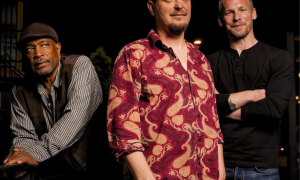April 30 to August 29, 2010 in Montreal
Designed and organized by the Cite de la musique, Paris, with the support of Miles Davis Properties, LLC, in collaboration with the Montreal Museum of Fine Arts, “We Want Miles": Miles Davis vs. Jazz is the first North American multimedia retrospective exhibition devoted to one the greatest jazz artists of the twentieth century: Miles Davis (1926-1991). 
Divided into eight thematic sections ranging from his childhood in East St. Louis, (MO) to his last concert at La Villette in Paris (1991), the exhibition features a wide range of exceptional works of art, archival materials, and objects, many of which are on view for the first time, that chronicle how Davis impacted the course of jazz several times throughout his life. They include rare or previously unscreened concert film footage; original musical scores; a selection of Davis trumpets and fellow band members' musical instruments; original documents relating to his albums; stage costumes; vintage pressings of his records, as well as compelling personal portraits taken by legendary photographers Annie Leibovitz; Herman Leonard; William Gottlieb; Dennis Stock; Baron Wolman; Amalie Rothschild; Lee Friedlander; Bob Willoughby; Anton Corbijn, and Irving Penn, among others. In addition, twenty listening stations will permit visitors to immerse themselves in the multiple musical currents reinvented by Davis: jazz, funk, rock, bebop, etc.
While examining the many ways Davis pushed the boundaries of jazz, the exhibition will also include a number of his original paintings (pictured). At first a means to rehabilitate his hand after a stroke, drawing and painting became a daily activity for Davis in the 1980s with select works appearing on his album covers and on stage at concerts. Further revealing Davis' reach beyond the sphere of music, the exhibition will feature a significant grouping of paintings and sculpture influenced by Davis by contemporary artists including: Jean-Michel Basquiat, Mati Klarwein, and Niki de Saint Phalle, among others.
Serving as an invitation to rediscover the music and the immense talent of an artist whose jazz innovations in the second half of the 20th century were profound in their scope and consequences, this initial venture into the realm of jazz continues the Museum's exploration of links between the visual arts and music launched with Warhol Live (2009) and Imagine: The Peace Ballad of John & Yoko (2009). Explained Museum Director Nathalie Bondil, “With 'We Want Miles', art lovers and music fans alike will be fascinated by the universe of this legendary figure who transcends time."
EXHIBITION THEMES
Miles Davis had an extraordinary flair for new trends and sounds. According to Exhibition Curator Vincent Bessieres, “Every five years or so he would revolutionise his music. Starting in bee bop, then birth of cool, then in large orchestras with Gil Evans and modern jazz with Kind of Blue then the so-called Second Quintet with Herbie Hancock and Wayne Shorter and then going electric with Bitches Brew, and going into funk with On the Corner.... [You can] divide his music into periods like you would for a painter." Divided into eight sections, the constant evolutions and revolutions that characterized Davis' musical output over his 40-year career will be displayed both chronologically and thematically as follows:
- From St. Louis to Fifty-second Street: In Search of Bird (1926-1948).
In this section, which traces the trajectory from Davis' childhood to the New York jazz clubs, visitors will discover the dream of bebop. Davis meets the leaders of bebop, Dizzy Gillespie and Charlie Parker, whom he seeks out in New York. - Out of the Cool: Invention and Self-Loathing (1949-1954).
Davis opens the way to cool jazz. In 1949, after a stay in Paris, where he encounters the intelligentsia of Saint-Germain-des-Pres, he returns to the United States and falls prey to drugs. He gathers the young black vanguard of the new hard bop (Thelonious Monk, Art Blakey, etc.), participates in various recordings, and develops a unique style. - Miles Ahead: In the Studio for Columbia (1955-1962).
The records of the consecration. In 1954, he quits drugs. Columbia gives him a contract. He creates Kind of Blue in 1959, as well as a number of ambitious orchestral albums, and achieves star status in the world of jazz. In Europe, his music for the film Ascenseur pour l'echafaud (1957) is a triumph. - Miles Smiles: Controlled Freedom (1963-1967).
Davis surrounds himself with young, incredibly talented musicians (Herbie Hancock, Tony Williams, Ron Carter, Wayne Shorter) and invents a free and intuitive style of jazz that would prove to be very influential. - Electric Miles: Rock Distortion (1968-1971).
A new era and a new look. Davis plugs into rock and contributes to the emergence of what will be called “jazz-rock." He receives his first gold record for Bitches Brew (1970), which leaves its mark. - On the Corner: Funk Beat (1972-1975).
The artist searches for the sounds of the street, the blackness of funk, and the impact of boxing. - Silence, Solitude and Requiem (1976-1980).
Battling with a number of problems, Davis stops appearing on stage in 1975 and lives as a recluse until 1980, when he makes a comeback. - Star People: Global Icon (1980-1991).
Miles Davis reinvents a way to make music that reflects the times. In 1986, the record Tutu garners accolades. The artist rises from the ashes and helps to forge his own legend. He participates in the Montreux Jazz Festival in 1991 and renews ties with former tour partners at La Villette in Paris.
CURATORS
The exhibition is curated by Vincent Bessieres, former associate editor-in-chief in 2007 of Jazzman Magazine, a commentator on the French radio station, France Musique, and on the TV channel France 5. He is also responsible for the editorial coordination of the content of the jazz section of the Mediatheque's portal for the education department of the Cite de la musique, and since 2006, has been in charge of the department's workshop on contemporary jazz. The Associate Curator is eric de Visscher, composer and director of Cite de la musique.
LENDERS
In addition to the many loans made by the artist's family, represented by Miles Davis Properties, LLC, the exhibition has also benefited from loans made by a great number of international private and institutional collectors, including the Broad Art Foundation, the Cinematheque franaise, the Institute of Jazz Studies, the L.A. Jazz Institute and the New York Public Library. It must be noted that many of the musicians who played at one time or another with Miles Davis, such as bassist Marcus Miller, trumpeter Wallace Roney and drummer Al Foster, made an exception and agreed to part with their instruments for the exhibition. World-class photographers Annie Leibovitz and Anton Corbijn also agreed to lend their original prints of the musician. In addition, Sony Music Entertainment, Warner Music Group, and the Festival International de Jazz de Montreal also contributed their invaluable assistance to the project by opening up their archives.
CATALOGUE
The first edition of the French version of the catalogue was published in Paris by editions Textuel and the Cite de la musique in 2009. The French edition of the Montreal catalogue will be published by the Montreal Museum of Fine Arts, with an English version copublished by the Museum and Rizzoli. This 223-page book includes some 200 images - a number of which are being published for the first time - and an essay retracing Davis's life and career over forty years by Franck Bergerot, a leading jazz specialist. Other contributors include George Avakian, Laurent Cugny, Ira Gitler, David Liebman, Francis Marmande, John Szwed, and Mike Zwerin.
EXHIBITION DESIGN
Conceived by the Parisian architectural firm Agence Projectiles, the exhibition is entirely designed to facilitate the appreciation of Davis' music and ease of listening. Small listening rooms placed throughout the installation, shaped in the form of the “mutes" Davis famously used on the end of his trumpets, allow the public to experience the artist's emblematic works in optimal acoustic conditions. Several large-scale projections of film footage from famed live concert such as his concert in Germany with the “second quintet" (1967); his 1970 Isle of Wight performance (full-feature), which marked his move from acoustic to electric; his 1985 concert at the Montreal International Jazz festival, and his 1991 testament concert in Paris, at La Villette, will also be featured in the exhibition.
SPONSORS
The exhibition is presented in Montreal by Sun Life Financial in collaboration with Sony Music Entertainment. The Montreal Museum of Fine Arts would like to thank the Festival International de Jazz de Montreal, Archambault and Air Canada, as well as its media partners La Presse, The Gazette, Astral Media and the Societe Radio-Canada. Its gratitude also extends to Quebec's Ministere de la Culture, des Communications et de la Condition feminine for its ongoing support.
The exhibition benefits from the support of the Volunteer Association of the Montreal Museum of Fine Arts. The Museum would like to thank the Association of Volunteer Guides of the Montreal Museum of Fine Arts for its invaluable support. It would also like to thank all its VIPs and the many corporations, foundations and people who support its mission, especially the Arte Musica Foundation, which is presided over by Pierre Bourgie.
The Montreal Museum of Fine Arts' International Exhibition Programme receives financial support from the Exhibition Fund of the Montreal Museum of Fine Arts Foundation and the Paul G. Desmarais Fund.
MUSEUM INFORMATION
Founded in 1860, the Montreal Museum of Fine Arts was the first art museum to be established in Canada and has grown to become Montreal's top cultural destination (source: Tourisme Montreal). The Museum's encyclopedic permanent collection of more than 35,000 works of art -- paintings, sculptures, works on paper, prints and drawings, photographs and decorative art objects reflects all the main trends in art from antiquity to today and features distinguished collections of Ancient Cultures, European Art, Canadian Art, Inuit and Amerindian Art, Contemporary Art, and Decorative Arts.
True to its vocation of acquiring and promoting the work of Canadian and international artists past and present, the Museum's mission is to attract the broadest and most heterogeneous public possible, and to provide that public with first-hand access to a universal artistic heritage. The Montreal Museum of Fine Arts:
1380 Sherbrooke West. Phone: 514-285-2000, Outside Montreal 1-800-899-MUSE.
Admission: The Museum's permanent collection is free. Admission to temporary shows such as Davis is $15 for adults, $7.50 for students under 30 with an ID card; $10 for people 65 and over; free for children 12 and under accompanied by an adult;
Museum hours: Tues., 11 am to 5 pm, Wed. to Fri., 11 am to 9 pm, Sat. and Sun., 10 am to 5 pm. Closed Mon.

























